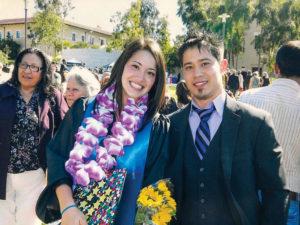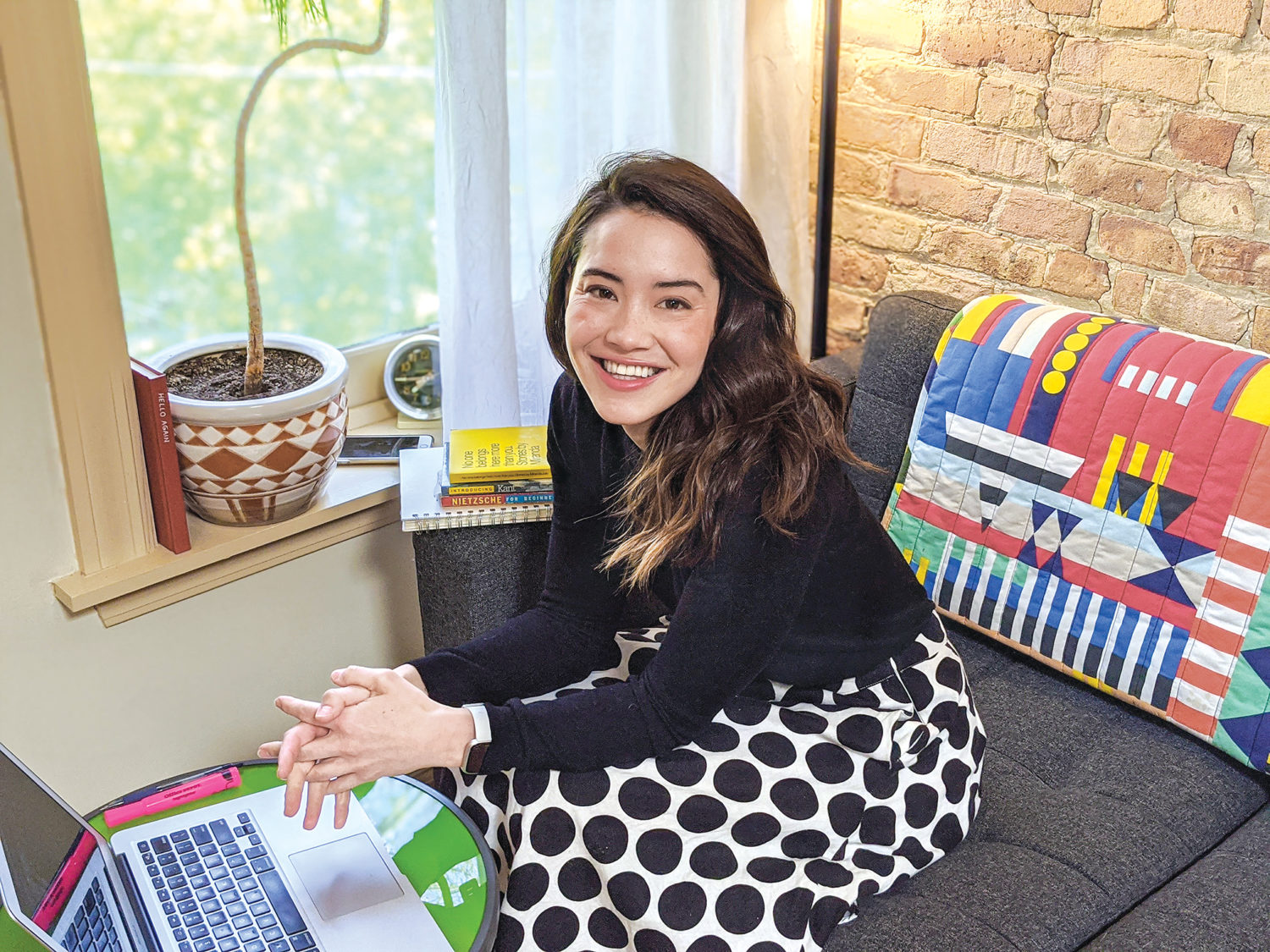Jenny Cook
Chicago
Living Buddhism: Thank you, Jenny, for sharing your experience with us. How did you start practicing Nichiren Buddhism?
Jenny Cook: Thank you for this opportunity to share. When my mom left Okinawa, Japan, to marry my dad, an American Navy seaman, her sister asked that she take the Gohonzon with her. She told my mom to chant Nam-myoho-renge-kyo to the Gohonzon whenever she was struggling.
Life as a Japanese immigrant in middle America was difficult—she didn’t understand English, my dad developed a drinking problem, and the two struggled financially. Keeping her sister’s words in her heart, she chanted earnestly and read every day the one book by Ikeda Sensei that she had.
As a child, I felt embarrassed about our Buddhist practice and wanted to be normal like my friends. At the same time, I saw how happy the practice made my mom. I often asked her if I could go to church with my friends, and while she let me explore freely, she always reminded me that genuine happiness was found within. Still, it wasn’t until I was in a life-threatening car accident that I fully embraced Buddhism.

Could you share what happened?
Jenny: It was the day after Thanksgiving in 2006, and I had just turned 18. I was in the car with my dad and brother, when an SUV cut us off. My body flew into the back of the headrest—crushing my face and breaking my mandible—before I slammed into the side door.
I was rushed to the hospital, and although my heart had stopped for two minutes, I survived. Laying on the gurney, I looked up at a round, mirrored light above me and saw the reality of my face. Ironically, it was exactly how I had felt on the inside for many years—unappreciative, cold and lifeless. At that very moment, I smiled genuinely for the first time. I was so grateful to be alive.
How did this become a turning point for you?
Jenny: I came out of the haze, immobile and unable to speak, with no movement in my face. While I was laying there in bed, my mom chanted beside me. For the first time, I heard Nam-myoho-renge-kyo so clearly and powerfully. I knew she was pouring her whole life into chanting for me.
I didn’t want to let my parents down, and I didn’t want to take anything for granted anymore. I determined to become a daughter who could fulfill her mission in life. Despite the immense pain, I pushed myself to chant, syllable by syllable.
After a little over a month of fighting in this way, I was finally able to say “Nam-myoho-renge-kyo” to my mom. She was overjoyed. We had won!
Also, my dad, who had fallen into a depression from the regret of putting his daughter in harm’s way, started practicing Buddhism earnestly. He started to take responsibility for his life and stopped drinking. Looking back, this accident awakened my appreciation for life and brought my family closer.
How powerful. How did life change from there?
Jenny: Sensei has always emphasized the importance of one’s life force. I’m convinced that it was because of the life force I gained from chanting that I recovered after only three-and-a-half months.
When I returned to school, there was one hurdle after another. I was so behind on schoolwork that I wasn’t sure whether I would graduate. Some classmates made fun of me for not having teeth; they were shattered in the accident. On top of that, my application to my dream school, Soka University of America, in Aliso Viejo, California, was waitlisted.
I saw this as a test to see how serious I was about fighting for my life’s mission. Sensei writes:
Real life … is filled with an unending series of problems, including such things as financial troubles, sickness and family disharmony. At such times, your circumstances may seem unfortunate, but if you keep chanting Nam-myoho-renge-kyo throughout, you will definitely transform all that is negative into something positive in accord with the Buddhist principle of “changing poison into medicine.” You can ride out every difficulty, turning it into an opportunity for growth. (The Vow of the Ikeda Kayo-kai, p. 5)
Together with my mom, I determined to wake up every morning at 4 a.m. to chant three hours before school. With abundant life force and clear goals, I no longer cared if people made fun of me. I still smiled, because I was just so happy to be alive. I overcame each hurdle, graduated on time with the support of my teachers, and I was accepted into SUA!
Congratulations! How did your experience at SUA impact the trajectory of your life?
Jenny: Back when I was 15, a friend in my local SGI community went to SUA and blossomed into such an open person, full of life. I wanted to experience what he did, and it sparked my interest in what Soka education could really do.
My first year was a struggle with my doubts and self-worth. But, I was reminded by my mom that the purpose of education was to help students bring forth their own potential—not to bring together students who were already perfect.
During my study abroad in Peru, I saw first-hand the lack of education accessible to children. This strengthened my sense of responsibility to serve those who are in need.
In my final year of school, I worked at an institution that supports students with behavioral impairments, and it changed my life. A young girl whom I had wholeheartedly supported passed away from a brain aneurism. I was overcome by immense sadness, but vowed in my heart to never stop working for children and to become an educator who would never give up on their students. I determined to embody Sensei’s spirit, the heart of Soka, and treat each student as a Buddha.
When I look back in this way, I owe a tremendous debt of gratitude to Sensei and SUA for helping me awaken to my life’s mission and teaching me the essence of education.
What is your role as an educator today?
Jenny: Currently, I am a learning behavior specialist who works with children with trauma related to incarceration, drug abuse and domestic violence. I help them connect their experiences in life to the value of education.
For example, one of my students struggles with depression and often shuts down during class. Rather than judging him, I looked into his interests. When I found out he liked maps, I incorporated them into our lesson. He became more engaged, and he began to open up. He shared that he wanted to leave home and live somewhere else. From there, we engaged in dialogue, which resulted in him realizing the importance of where we are now.
My utmost priority is to build relationships with my students, accept whatever behavior they display, and in turn, embrace them with care. I believe it’s my responsibility to encourage them, rather than punish them, and to provide an education they see as valuable. I feel there is no separation between my Buddhist practice, the training I receive in SGI activities and my role as an educator.
How does your Buddhist practice enhance your role as an educator?
Jenny: In my years of teaching, I’ve lost students to gun violence, drug abuse and suicide. This reality has brought out deep sadness and doubts about the impact I could have.
In such moments, I write memos to Sensei, honestly sharing with him my struggles and redetermine to continue fighting for the happiness of my students.
Every day is a battle. Sometimes my students will curse at me or tell me that I have no idea what they’ve gone through. But I know that to help my students grow and develop, I need to have a strong and expansive heart, overflowing with life force. The only way to do so is to win in the morning with abundant prayer. Sensei writes:
If we’ve done something we regret, we can chant with a determination never to repeat the same mistake, making our prayer the first step toward a new and better future. When we face a decisive challenge, we can chant strongly and courageously with the firm resolve to win. When battling the three obstacles and the four devils, we can chant with the heart of a lion king, filled with confidence that we’ll vanquish those negative functions. When we’re faced with the opportunity to transform our karma, we can infuse our prayer with an unwavering resolve not to be defeated. When we’re happy about something, we can chant with a deep spirit of appreciation and gratitude. What matters is that we continue chanting Nam-myoho-renge-kyo throughout all, “regarding both suffering and joy as facts of life” (see “Happiness in This World,” The Writings of Nichiren Daishonin, vol. 1, p. 681), as the Daishonin teaches. (Learning From Nichiren’s Writings: The Teachings for Victory, vol. 2, p. 134)
The more I develop my Buddhist practice, the stronger I become. And when I unite in my heart with Sensei’s vision for kosen-rufu, I can fully embrace my students and give them hope.
How have you adapted to distance-learning amid the COVID-19 pandemic?
Jenny: When we went into quarantine and the students couldn’t physically come to school, it was difficult to keep them on track. So, when the SGI-USA announced the A-B-C Campaign—abundant prayer, Buddhist study and connecting life to life—I knew this was it.
I started with abundant prayer in the morning, chanting for the safety of my students and trying to come up with new and creative ways to continue engaging with them. The most important thing I could do was to continue reaching out, one to one, to see how each of them was doing. I knew that no amount of reading assignments would shift their hearts; only life-to-life connections could give them hope.
Before the shutdown, I had a student who stopped attending school. I kept chanting and writing him letters, determined to never give up on him. I’m so happy to report that he emailed me recently, letting me know that he hasn’t given up.
These students teach me the power of our lives, and the importance of persevering in our efforts. No matter how busy I am or how defeated I feel in the moment, I’m determined to always be present for them.
Thank you very much for all of your efforts to give young people hope. What are your determinations in this significant year—personally and as the newly appointed Chicago Zone young women’s leader?
Jenny: Having lived in different parts of America, I see the reality and inequity of education firsthand. And as someone who was fortunate enough to receive wonderful opportunities, I have an obligation to give back to my community. That’s why my dream is to build a special education school in America based on the principles of Soka education. I want to transform the apathy in our society by empowering the youth to live contributive lives.
I have tremendous appreciation for my seniors in faith and the young women’s leaders for pulling me out of self-isolation and helping me overcome my own lack of confidence. It’s thanks to them that I’ve been able to open up my heart and muster the courage to take action, resulting in the career and relationship with my significant other that I enjoy today.
So, as the Chicago Zone young women’s leader, my determination is for each young woman to confidently say that they love their life and are happy. I want each of them to have Sensei in their heart, because then, they can overcome anything.
Sensei, the youth in Chicago will stand up and never be defeated! We will be the next generation of youth leading the way for kosen-rufu in America!
You are reading {{ meterCount }} of {{ meterMax }} free premium articles

